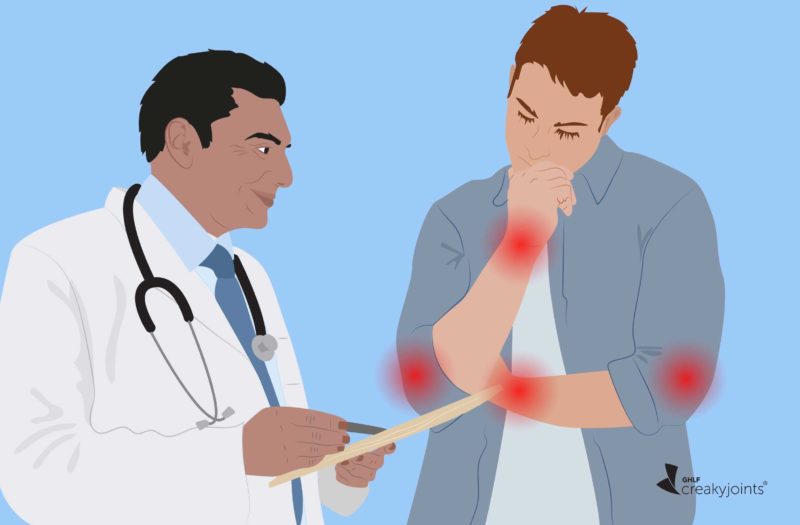Key Takeaways
- ACR Response Criteria indicate how much you’ve improved, but both physician- and patient-reported data factor in.
- New research suggests that physician-reported factors are often what’s driving ACR20, meaning a patient is believed to have improved at least 20% since the last time their disease activity was assessed.
How well is your rheumatoid arthritis (RA) treatment working? In a typical practice, your doctor might just ask you how you’re feeling, check for swollen and tender joints, and draw a vague conclusion. In clinical studies, however, this question is more specifically calculated. Generally speaking, a drug being tested is not considered effective unless patients using it demonstrate that they’ve improved at least 20 percent on it.
This 20 percent marker is measured according to specific response criteria that have been set by the American College of Rheumatology (ACR). When someone improves at least 20 percent according to these criteria, they’re said to have achieved ACR20 response.
That all seems straightforward enough, but ACR20 response is based on several factors. In order to reach it, a patient must have improved at least 20 percent in terms of the number of tender and swollen joints they have, plus they must have improved at least 20 percent on at least three out of five of these criteria:
- Patient global visual analog scale (VAS): A patient’s overall assessment of how their disease is current impacting them; patients mark a line that ranges from “not at all” to “very severe.”
- Patient pain VAS: A pain scale; patients mark a line to indicate their current level of discomfort, from “no pain” to “worst pain.”
- Health Assessment Questionnaire (HAQ) Disability Index: A 20-item scale that asks patients to rate their ability to do regular activities such as getting dressed, walking, gripping items, etc.
- Physician global VAS: A physician’s overall assessment of how severe a patient’s condition is.
- ESR or CRP values: Erythrocyte sedimentation rate (ESR) or CRP (C reactive protein); these are blood tests that measure inflammation.
Physician-Reported vs Patient-Reported Outcomes
The first three of these five items are considered patient-reported outcomes; the last two are physician-reported ones. The number of tender and swollen joints is also a physician-reported measure.
In a new study, published in The Journal of Rheumatology, a group of international researchers set out to determine which of these factors end up having the most weight when a patient is said to have achieved ACR20. And it turns out that physician-reported ones usually win out.
To conduct the research, the authors analyzed data from two earlier randomized controlled trials that pitted tofacitinib (Xeljanz) against adalimumab (Humira) or a placebo. They determined that physician-reported measures “typically contributed more to ACR20/50/70 response rates… than patient-reported measures at month 3. This may be because of differences in the type of information collected between physician-reported and patient-reported measures, or discrepancies in disease or symptom perceptions between the physician and patient.”
ACR50 refers to an improvement of more than 50 percent, and ACR70 refers to an improvement of more than 70 percent. For obvious reasons, ACR50 and ACR70 are more difficult to achieve than ACR20, but they do happen. Interesting, when patients achieve ACR70, their perception of their disease tends to be more closely aligned to their doctor’s perception, according to this study.
The authors speculated that “patient and physician perceptions of disease status may be more closely aligned for patients achieving [low disease activity] following RA treatment.” In other words, when treatment is working really, really well (ACR70), patients and their providers are more likely to be in sync.
Since an ACR70 response isn’t as easy to achieve as ACR20, the main takeaway is that physician-reported outcomes might be getting undue weight if you consider patient satisfaction to be the ultimate goal. “ In particular, the higher weighting of physician-reported vs patient-reported components to overall response and remission highlights the importance of considering the patient’s perspective when making treatment decisions,” the researchers concluded.
What This Means for You
If you don’t feel like treatment is helping you enough, speak up. Your number of tender and swollen joints and blood test results are only part of the equation.
It’s also important to make sure your doctor understands your personal treatment goals. Work closely with your doctor to adjust your treatment as needed to reach your treatment goals. This is the crux of a treat-to-target strategy and effective shared decision-making.
More From the Voice of People Living with RA
Research shows that patients seek information from their peers to make decisions about medication and disease management. CreakyJoints produced a series of videos where people from diverse backgrounds who are living with RA candidly share their experiences with RA treatment — from starting treatment to switching medications to dealing with methotrexate side effects. Watch the frank patient-to-patient discussions in our video series here.
At a glance: Common scores used in rheumatology. Medicine Matters. https://rheumatology.medicinematters.com/treatment/patient-reported-outcomes-/at-a-glance-rheumatology-scores/16077860.
Bessette, L. “Impact of Tofacitinib on Components of the ACR Response Criteria: Post Hoc Analysis of Phase III and Phase IIIb/IV Trials.” The Journal of Rheumatology. March 2022. doi: https://doi.org/10.3899/jrheum.210707.






